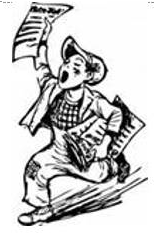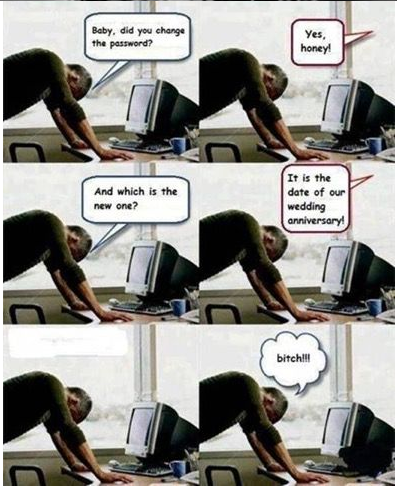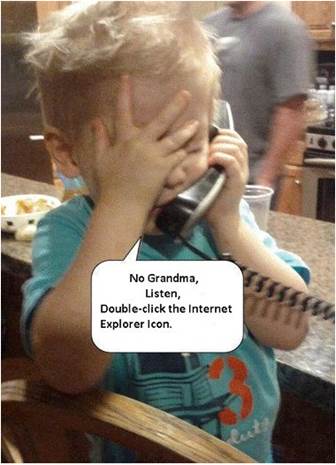
Part of the worldwide genealogy/family history community
ISSN 2253-4040
Quote: “To be old and wise, you must first be young and stupid”
Contents
Do you want to receive this newsletter every month?
FamNet Membership, Subscriptions, and Group Membership
Genealogy – A Rumsfeldian Approach
DNA Testing for Family History
Surprises that can come from unlikely sources
Digging Into Historical Records
Wellington Provincial Correspondence: John Farrell (1833-1861) – who was he?
More Famous New Zealanders You have Probably Never Heard Of
Are We Ready To Talk About Soiled Doves?
From our Libraries and Museums
Whangarei Family History Computer Group
Waitara Districts History & Families Research Group
The women of the New Zealand goldfields
Australian Shipping and Passenger Records. 1
How to find divorce records in England and Wales
How to find name change records in the UK
Here’s to the Non-Genealogists
To Unsubscribe, Change your Email Address, or Manage your Personal Information
Editorial
 Hello fellow genealogy nutters
Hello fellow genealogy nutters
Greetings and welcome to another issue of the FamNet newsletter.
Thanks very much for the response from our readers who have reacted to my begging in the last issue for articles. I have some held back in reserve for the next issue now. Please keep writing up the results of your research – it is one way of attracting your bored relatives access to their ancestry.
Robert and I have a desire that “regular” researchers have a place where they can publish their articles about family history and/or genealogy. I, particularly, hold a strong view that we all should write up the results of our research. This doesn’t have to be in a format and language that is scholarly or “posh”. I write so that my grandchildren understand and appreciate their ancestors. This newsletter is a regular publication that takes pleasure in being a medium for short, sharp articles from anybody. We pay high rates ( $0 ) to writers, we charge high rates ( $0 ) to readers. So keep the articles coming.
The other side of the coin also needs addressing. Our readership is dropping. I suppose that it isn’t surprising that this is so because researchers, being elderly in the main, keep regularly “falling off our perch”, “losing our marbles” i.e. dementia etc, or just simply changing our email address. Some of our writers (me in particular) have egos that need regular massaging. We need an audience (or, at least, I do). Therefore, please tell your research buddies to sign up to receive the monthly newsletter.
Anyway, back to reality. Once again, we have an interesting newsletter. The articles are varied. The jokes are funny although they are not the main reason for reading the newsletter.
I hope this month’s issue occupies some of your time and you find something valuable.
Peter Nash
Do
you want to receive this newsletter every month?
This newsletter is free. There are not many free newsletters of this length in New Zealand. I am biased but it should be an interesting read.
To subscribe is easy too. Go on - don't misspell it as I have, twice already. http://www.famnet.org.nz
The front page is lovely, but click on [Newsletters]. A page opens showing you a list of all the past newsletters, you can click the link to read one that you’re interested in.
Like the front page, the newsletters page has a place where you can log on or register. It’s in the top right-hand corner. Put your email here and click [Continue]. If you aren’t already on our mailing list, there will be a message “Email not in database” and a button [New User] appears. Click this and follow the dialog to register. It’s free and easy. You should receive a copy every month until you unsubscribe.
Robert has assured me that he will not send begging letters to your email - apparently, he has enough money at the moment. You will not have to put in your credit card number. You will not be charged a subscription.
Tell other genealogists so they can enjoy the newsletters too.
Regards
Regular Contributors
From
the Developer
 FamNet Membership, Subscriptions, and Group Membership
FamNet Membership, Subscriptions, and Group Membership
The last FamNet newsletter was sent to 5465 people, but every time there are a number of bounces, where an email address no longer works. Last month when I went through the bounce list to clean up the database there were 35 were bounces, so next month it will only go out to 5430 people unless we have more new members. We’re steadily, if slowly, losing people. So please, please, please tell your friends and families to join FamNet, it’s easy, tell them just click http://www.famnet.org.nz and follow the New User dialog to register.
Our friends in Utah who pay an annual fee to offer FamNet at the Family History Library and to their Family History Centers around the world. A few months ago they generously agreed to a proposal: they agreed to double the amount that they pay annually, to allow me to make FamNet free. So there are no subscriptions, any member will not only get the newsletter, they will be able to look up people in the Genealogy Database (GDB) with all the rights that previously cost $30 per year.
We’re going to make a change to Group Membership. Previously, to be featured in the Group News section required a group subscription, discounted to a percentage of the annual subscription. We are grateful to these groups for the support that we’ve had from them in the past, but now that FamNet is funded by the Mormons this is no longer relevant and it’s been a while since we had any financial support from the groups featured. So it’s time we made a change. From next month, any group can be featured in this section if they either share their email list with us (we’ll add their emails to our database), or else agree to forward our newsletters to their list every month. We’d prefer to have the emails as this reduces duplication – many of their email list will already be registered individually – but we appreciate that they’ve been given emails for their own use and it may not be possible for them to simply copy their list.
Hopefully we’ll see many more groups “joining” with these new rules.
Telling your story: Index
1. Writing your story as notes, or with Word.
2. Embedding pictures in Word documents.
3. Saving Documents for Web Publication.
5. Sharing your Story: Managing your Family Group
6. On Line Editing: More Facts, Family, GDB Links
7. Comparing and Synchronising Records
9. Merging Trees. Part 1: Why Bother?
10. Merging Trees. Part 2: Adding Records On-Line
11. Merging Trees. Part3. Combining Existing Trees
12. Finding Your Way Around FamNet (Getting Help)
13. FamNet – a Resource for your Grandchildren
14. FamNet’s General Resource Databases
15. Updating
General Resource Databases
16. Privacy
18. Linking trees
20. Uploading Objects to your Database
21. Bulk-uploading Objects. FamNet resource: Useful Databases
22. Publishing Living Family on Family
Web Sites
23. Have YOU written your family story yet?
24. Editing and Re-arranging your Family Tree On-line.
25. It’s the Stories that Matter
26. Using QR Codes for your Family History
27. What happens to our Family History when we’re gone?
The Nash Rambler
Genealogy – A Rumsfeldian Approach
 If you have been reading my column for
some time you will know that I like to keep up with the new trends in genealogy
sources and research methods. I have written about developments such as ethics,
privacy etc as soon as I became acquainted with them and their relationship to
genealogy ( I don’t mean that I have only recently
become aware of ethics!) Genealogy research methods change so rapidly – it was
not that long ago I was glued to a film reader. To this end I am obliged to
draw your attention to this article which may be of assistance to you.
If you have been reading my column for
some time you will know that I like to keep up with the new trends in genealogy
sources and research methods. I have written about developments such as ethics,
privacy etc as soon as I became acquainted with them and their relationship to
genealogy ( I don’t mean that I have only recently
become aware of ethics!) Genealogy research methods change so rapidly – it was
not that long ago I was glued to a film reader. To this end I am obliged to
draw your attention to this article which may be of assistance to you.
The Family Tree Magazine for February 2022 has an article with the title “Genealogy – A Rumsfeldian Approach”.
Donald Rumsfeld was US Secretary of Defence in 2002 and made the following magnificent statement:
“There are known knowns – things we know we know…..There are unknown unknowns – the ones we don’t know we don’t know.”
The author, Alfred Gracey, has designed a research model based on Rumsfeld’s quote. In any subject he is researching he divides his research plan into four subsets:
·
Known knowns
·
Known unknowns
·
Unknown knowns
·
Unknown unknowns
He then sets about his article using these four headings in a grid pattern. He then launches into his article about how to research. It is a little too theoretical and shows how some genealogists can disappear down rabbit holes. I have to admit that I couldn’t read the whole article and there are very few times I can or could say that.
 Are
you confused? I am. I can work out what a known known is – a fact I have found
and proved e.g. a birth date and place, found on a
birth entry. I can work out what a known unknown is – a fact I know exists and
I have not found it e.g. a marriage because I haven’t
got the certificate. I assume an unknown known is a fact I have but not
realised it – e.g. I haven’t read a certificate properly and have missed the
fact that a wedding certificate has a sibling as a witness and I haven’t found
that person yet. But an unknown unknown has got me stumped!!!!
Are
you confused? I am. I can work out what a known known is – a fact I have found
and proved e.g. a birth date and place, found on a
birth entry. I can work out what a known unknown is – a fact I know exists and
I have not found it e.g. a marriage because I haven’t
got the certificate. I assume an unknown known is a fact I have but not
realised it – e.g. I haven’t read a certificate properly and have missed the
fact that a wedding certificate has a sibling as a witness and I haven’t found
that person yet. But an unknown unknown has got me stumped!!!!
This would be the most confusing article on research and research methods that I have ever read. I can’t even say the previous paragraph listing the various categories without breaking out into hysterical laughter. I couldn’t understand the article at all. I have tried to read it a few times but I get lost. I have thought about this for a few weeks and I am still confused. I think I will continue to research as I have done for nearly thirty years. I won’t waste time trying to sort the data on a particular research question into the writer’s suggested categories – my brain cannot comprehend what an unknown unknown is, let alone categorise it.
Applying a warmongering Yankee leader’s statement to genealogy research is a bit farfetched. Maybe sometime soon an article will appear on research methods based on Trumpian quotes, actions or behaviour. I can’t wait to see one on the disinfectant method of research – inject it into your database and the “baddies” disappear. Hang on I could write that!
I wish to suggest that you read the article. That will result in many more confused researchers and I won’t feel so stupid. Please write to me and explain, if you can, how this article and method would make me a better researcher.
PS I apologise for this useless article. I’m afraid too much laughter led to a lack of concentration and I “lost the plot”. I promise to improve next month.
DNA Testing for Family History
Surprises that can come from
unlikely sources
 As many of you will already know, I
administer a number of projects (whether Surname Projects or Haplogroup
Projects or Geographical Projects) for FTDNA.
As many of you will already know, I
administer a number of projects (whether Surname Projects or Haplogroup
Projects or Geographical Projects) for FTDNA.
When I am asked to take on a new project (there are a number of reasons why this happens) by FTDNA, one of the first things I do is to turn on the Activity Feed. I do this because this is the in-house forum which is dedicated to that particular project. The information that comes into such a forum means it can be retained in the project – unlike Facebook forums. I also make it available to members only, meaning non-members cannot access it. This gives it a modicum of privacy. (Very important when members forget to remove identifying names when they post graphics with full names in view).
I introduce myself and let the members know what my intentions are which is usually to sort out all the Ungrouped members and place them into subgroups.
I delight in a project being mostly Y111 (or Y67) and Big Y testers. Unfortunately, many projects are riddled with Y12s and Y25s. I used to think it was because of the cost of the higher levels of testing, however I have since learned that they are testers from yesteryear when Y37 was considered the ‘top-of-the-line’ test. To encourage those testers to upgrade because of the great advances in technology is an arduous road.
The same outdated thinking belongs to single SNP testing and SNP pack testing. While both types of test for the male’s Y chromosome are still available, they are well out of date and for a few dollars more, the male tester can get all he could possibly need with the Big Y 700 test. (And yes, in the not-too-distant future, this too will be overtaken by another type of test.) We have so much more to learn from the Big Y test.
Yes, the Big Y results can be complex to read – every day I have requests for help to understand the outcome of such a test. The major question is “why do I have no matches?” followed by the question “why do I not see my surname amongst the matches?”
The main responses to such questions include:
No matches mean no one else in the tester’s family has taken the test, or
There has been a name change, or
The SNP found is actually quite old (this happens when there are a number of variants – yet to be named), or
The first set of results are through, but FTDNA requires more time to manually compare the variants within the data base of other tester’s variants.
This matter of a ‘variant’ appears to confuse testers.
A variant is the scientific position on the Y chromosome which represents a SNP (Single Nucleotide Polymorphism) but which has not been named as a SNP. FTDNA does not name these positions until another matching variant has been found in another tester. To reduce the variants, Administrators who know of these things along with FTDNA try to encourage more Big Y testers. This is often seen a simply a push to spend more money, but now you know there is a scientific reason behind the encouragement.
This is an example of a SNP named R-A752
SNP A752 Genotype T Reference C Position 19816642

The graphic is an example of a Y chromosome browsing tool.
R= the R1b Haplogroup
A752 = the SNP name at position 19816642
Genotype T = a mutation at that position because C (Cytosine) is the expected ancestral result as opposed to T (Thymine).
Should there be other testers with the SNP R-A752, then automatically we know that they are kin. But we do NOT know the date the common ancestor lived. This is where your genealogy research becomes important. Genealogical research is far bigger than just learning the names of your ancestors. It also includes their geographical locations, the dates (not just for births, deaths or marriages), their homes; their occupations and even others in their communities. It also includes detail about spouses, children and their spouses.
Remember to also consider what was happening in their geographical area at those times; the political climate; the medical knowledge available; the type of industry in which your ancestors were engaged. In other words, you are attempting to learn what the motivations might have been for their decisions and the outcomes.
It is sad to have learned that even though the 1860s was only 162 years ago, I have only minimal knowledge of what my ancestors went through in their daily lives. For example, what were their individual hobbies and did they even have time to indulge in such pursuits back then? Papers Past gives us a certain amount of information but unless a matter was reported, I have no idea if any of my ancestors back then were drunkards or had lovers or even if they could read and write.
Testing for genetic genealogy has brought me surprises. Such surprises see me going down a ‘rabbit hole’ but each time I am in that ‘rabbit hole’, I learn a little more about the backgrounds of the particular family I am chasing.
So why do I get so involved in running these projects?
The short answer is that they enable me to learn more. And the more I learn, the more I realise how similar we all are. This realisation plus the use of both autosomal testing for as many members of my family who will allow me and Big Y testing for the males in my family, has filled in many gaps. Many more await me…
From the editor: Gail has written quite a series on DNA Testing. You will see them all on the FAMNET website and they are a must-read, particularly if you are considering or have had a test done. They are easy to read and not too technical. Click Index so far to see these articles
Digging
Into Historical Records
Wellington Provincial Correspondence: John Farrell (1833-1861) – who was
he?
 On 17 December 1861 John Morrison, the New Zealand Government Agent in
London, forwarded a letter from either a “Mrs. Farrell” (my transcription of
the inwards correspondence register) or James Farrell (Archives NZ Collections
search) inquiring about a relative who had died in New Zealand. [1, 2]
On 17 December 1861 John Morrison, the New Zealand Government Agent in
London, forwarded a letter from either a “Mrs. Farrell” (my transcription of
the inwards correspondence register) or James Farrell (Archives NZ Collections
search) inquiring about a relative who had died in New Zealand. [1, 2]
The letter is part of a bundle of letters under IA1 1862/2164. At present I have yet to work out how to find the correct reference to be able to request the item using the new system. However, the transcript of the register for that number reads “Transmits a copy of Acts of Colony of Queensland”. Entering the keywords Queensland and 1862 into Collections Search returned the desired entry and it listed 19 letters in the bundle including Morrison’s letter. [3]
The Colonial Secretary at the time was William Fox [4] and in response he wrote on 7 May 1862 to the Superintendent of the Wellington Province. This letter was found in a box of at least 200 undescribed letters. Fox requested particulars of the death of John Farrell “who is supposed to have died in Wellington… I append a copy of the particulars respecting him in possession of the foremoment.
Questions Answers
1. Real Christian and Surname John Farrell
2. If known by any other name, state the same Not aware of any
3. Trade or Occupation Spindle and Flyer Maker
4. General Personal Appearance Height 5 ft 8in, stout, good looking, fair complexion
5. Usual residence before coming to Colony No.17 Harrison St, Pollard St, Ancoats, Manchester
6. Age Fifty
7. If married or single Single
8. Name of ship in which he emigrated, date of her departure and from whence she sailed?
The “Bond Venture” Captain J. Wilkie 1st August 1854, owners Houghton, Smith & Co., Canada, Docks Liverpool.
9. When last heard of and at what place? River Hutt, New Zealand at Mr Philips
10. Any other information which might facilitate the identification of the missing person?
Two large boxes with his name marked in full.” [5]
Isaac Featherston, the Superintendent, [6] duly made enquiries and a written reply was received from Patrick Donnelly (1819-1869). Writing from Lower Hutt on 20 May he said “I have made inquiry about the man Farrell he left the Wellington Road about the end of last summer 12 months and went into the hospital and died there. He was the only man of that name I ever knew about the hutt.” [7]
On 30 May 1862 the Superintendent wrote to the Colonial Secretary respecting Farrell and enclosed a letter from the Provincial Surgeon. [8] Again this correspondence is within a bundle of letters. Using the register transcript and entering the subject description into Collections Search revealed the correct reference to request. [9]
Farrell’s death in 1861 was registered in Wellington. [10] There were no entries found in an index to the Wellington Hospital Admission and Discharge Book 1847-1880 [11,12] and no reference has been found for his burial. He died intestate and the Registrar of the Supreme Court for the Middle District, Robert R. Strang, placed a notice, dated 21 June 1862, in the Wellington Independent asking creditors to come in and prove their debts “or in default thereof they will be peremptorily excluded from all benefit arising from the Estate.” [13] Further details may have been published in the 1861 New Zealand Gazette. [14]
Can any of Farrell’s provided biographical details be confirmed?
Starting with the voyage from England the Lloyd’s Register of British and Foreign Shipping 01 July to 30 June 1855 (Google Books) records a ship by the name of Bonaventure – Master Bainbridge; Built in Quebec under Special Survey in 1853; Owners Houghton and belonging to the Port of Liverpool. It was part of the Mersey Line of Australian Packets and its imminent departure from Liverpool for Melbourne was advertised in July 1854. [15] The ship arrived at Melbourne with 226 passengers on 29 October 1854. [16] John Wilkie, the master of the ship was subsequently charged for “not giving proper and wholesome provisions” and was ordered to compensate most of the passengers. [17]
This confirms that John Farrell would be in the 1851 English Census. Entering 17 Harrison Street, Manchester into the Findmypast address search revealed a Farrall family at the address. All members were born in Manchester.
James Farrall, head, 40, Officer to the Guardians of the Poor; Ann, wife, 40yrs
Sons John, 18, spindle maker; Robert, 10, scholar; and daughters Catherine, 6; Mary Ann, 4; Jane 2
Ten years later the family are living at 192 Great Ancoats Street, Manchester.
James Farrell, head, 50, Overlooker Board of Guardians… Manchester Workhouse; wife Ann, 50
Sons John, 21, eng… fitter; Robert, 19, Brewer’s assistant; James, 7, scholar
Daughter Mary Ann, 14, House
So, it was the parent of John Farrell of Hutt River, who wrote to John Morrison in London.
[1] Transcript of Colonial Secretary’s Inwards Correspondence Register 1862 https://www.nzpictures.co.nz/ia1862.pdf
[2] Archives NZ Collections Search R24134413 Colonial Secretary’s Inward Correspondence IA1 1862/987 – From John Morrison - Copies of letters from Mr John Davenport and Mr James Farrell inquiring respecting relatives who have died in NZ – with IA1 1862/2164.
[3] Archives NZ Collections Search R24134401 Colonial Secretary’s Inward Correspondence IA1 1862/2164 Bundle of 19 letters including Morrison’s 1862/987
[4] Wikipedia: Colonial Secretary of New Zealand https://en.wikipedia.org/wiki/Colonial_Secretary_of_New_Zealand
[5] Archives NZ Collections Search R17833766 General Inwards Letters and Letters from the Commissioner of Crown Lands and the General Government – Wellington Province WP 3/10 1862 letters 1-400 – Letter 1862/253 Colonial Secretary
[6] Wikipedia: Superintendent (New Zealand) https://en.wikipedia.org/wiki/Superintendent_(New_Zealand)
[7] Archives NZ Collections Search R17833766 General Inwards Letters and Letters from the Commissioner of Crown Lands and the General Government – Wellington Province WP 3/10 1862 letters 1-400 – Letter 1862/284 Patrick Donnelly 20 May 1862
[8] Archives NZ Collections Search R24133915 Colonial Secretary’s Inward Correspondence IA1 1862/1273 – From Superintendent Wellington respecting John Farrel – with IA1 1862/1266.
[9] Archives NZ Collections Search R24133911 Colonial Secretary’s Inward Correspondence IA1 1862/1266 – Bundle of six letters including the Superintendent’s IA1 1862/1273
[10] NZ Deaths Microfiche – 1861 John Farrell, folio 98 = Wellington (& Ancestry NZ Death Index)
[11] New Zealand Genealogical Society Kiwi Collection: Wellington Hospital Register 1847-1880
[12] Archives NZ Collections Search R2263268 As the description for this item is “Admission & Discharge Book” it will not be returned via search if the keyword “Wellington” is included.
[13] Wellington Independent 25 Jun 1861 In the Supreme Court of New Zealand, Middle District: In the Estates of Joseph Cook and John Farrell both of Wellington, deceased Intestate.
[14] Archives NZ Research Guide: Life Events – Other Estate Records https://www.archives.govt.nz/search-the-archive/research-guides/identity/life-events
[15] Northern Ensign and Weekly Gazette 27 Jul 1854 Advertisement
[16] Geelong Advertiser and Intelligencer 31 Oct 1854 Shipping –
Melbourne Arrived
[17] Colonial Times 14 Nov 1854 Shipping Intelligence
Pandora Research
Chinese
Corner
|
|
Anne Sherman
The
Natural child
 In 2015 when I was still relatively new to
professional research, I was engaged by an American genealogy company to
research John Billington who sailed on the Mayflower
in 1620. He travelled with his wife Eleanor and two adolescent sons John Jnr
and Francis.
In 2015 when I was still relatively new to
professional research, I was engaged by an American genealogy company to
research John Billington who sailed on the Mayflower
in 1620. He travelled with his wife Eleanor and two adolescent sons John Jnr
and Francis.
My research found that John Jnr was the son of John Snr and his first wife Cysly. John and Cysly were married in Thurlby by Bourne, Lincolnshire in 1603 and John Jnr was baptised the following year. Cysly died in 1607. Records in America correctly gave John Jnr year of birth as 1604 and gave the year of birth of Francis as about 1606. No baptism of Francis was found in Lincolnshire. A closer look of the evidence found by the client and a previous researcher noted an entry dated 1637 that stated that Eleanor referred to Francis as her “Natural” son. This immediately suggested to me that Francis was actually illegitimate; however, John could still have been his father. What surprised me at the time that neither the genealogy company, the previous researcher or the client had picked up on that simple, single word. In fact, the client’s reaction was one of shock! Had I got it wrong?
Since then, I have come across many examples of a child being described as the “natural” son or daughter and in almost every case the mother was either unmarried or described as a widow. One of the few exceptions was the baptism on 11 Oct 1767 of Jonas the natural son of Jonas and Hester Jones in Penmaen, Wales. None of the other baptisms on this page described the children as being natural. Looking further down the page however, the answer becomes evident. On 23 May 1768 Jonas Jones married Hester Lewis.
So what does it mean when Wills give a child’s relationship to a man as his “natural and lawful” child? The Familysearch website states “The child described in a will as "natural and lawful" is legitimate. The use of the word "natural" alone does not, however, imply illegitimacy, being used to mean "real son", not son-in-law, stepson or adopted son. Wills are not usually reticent about illegitimate children, but where there is some sensitivity they may sometimes appear without any relationship being stated.”[1] The Oxford Reference Dictionary also suggests that a “natural” child could refer to “An illegitimate child” or “A child of one's body, as opposed to an adopted child.”[2]
In general, if the term “natural” is used to describe a child, then that child will be illegitimate, especially in parish registers. If a man talks about his natural son/daughter the child may still be illegitimate but accepted and acknowledge by the father. In Will’s, however, the term “Natural and Lawful” will always mean legitimate, and not adopted, ‘in law’ or a stepchild. Not all Will’s use these terms, so if it does it may suggest the presence of other children.
Confused? This is where good research comes in. Work on the guidelines above but always try to prove who the parents were and when they married. As with the Billington family described above, never assume you know who the parents were. Illegitimate children often take the surname of a step-father, and in some cases so could young stepchildren.
[1] Illegitimacy in England. [adapted from an article "Records of illegitimate children" by Anthony Camp in Family Tree Magazine (UK), vol. 17, no. 7 (May 2001), pages 7-9]. Accessed: https://www.familysearch.org/en/wiki/Illegitimacy_in_England on 14 Feb 2022.
[2] Oxford Reference: “ Natural Child”. Accessed: https://www.oxfordreference.com/view/10.1093/oi/authority.20110803100225219 on 14 Feb 2022.
More
Famous New Zealanders You have Probably Never Heard Of
Malcolm Fleming (1870 - 1945)
 Malcolm Fleming was born in Thames on the
30 January 1870, the eldest son of Andrew and Eliza Ann Fleming née Kerr. A few
days after their marriage Andrew and Eliza left London for Auckland on board
the Bombay arriving
in Auckland on the 8 December 1863. The couple settled in Thames where Andrew
was an auctioneer. He is said to have served with the Auckland Militia during
the land wars. At the same time his brother James Henry Fleming was serving
with the New York Light Cavalry during the American Civil War and was killed in
1864 at Fairfax, Virginia.
Malcolm Fleming was born in Thames on the
30 January 1870, the eldest son of Andrew and Eliza Ann Fleming née Kerr. A few
days after their marriage Andrew and Eliza left London for Auckland on board
the Bombay arriving
in Auckland on the 8 December 1863. The couple settled in Thames where Andrew
was an auctioneer. He is said to have served with the Auckland Militia during
the land wars. At the same time his brother James Henry Fleming was serving
with the New York Light Cavalry during the American Civil War and was killed in
1864 at Fairfax, Virginia.
Malcolm was educated at the Kauaeranga Boys School, Thames High School, and the Thames School of Mines where he passed exams in assaying, mining surveying and chemistry. He began prospecting throughout the Thames districts and worked in various mines gaining practical experience. He also prospected for coal on the West Coast for the New Zealand Government as well as managing magnesium mines on Waiheke Island.
In 1890 he took over an old mine (Earl of Glasgow) at Karangahake which was said to have been worked out. He erected a five-head stamp battery on the property, and it soon yielded 10¼ ounces to the ton. He eventually sold this to the New Zealand Exploration Company for £120,000 and took up another gold field in the area on which he discovered some very large reefs including the Talisman lode. This was also sold to the New Zealand Exploration Company and eventually made pay-outs exceeding £10 million. He was also responsible for the discovery of the Golden Cross mine in the upper Waitekauri district. With the success of the Talisman and Golden Cross mines, plus the Waihi Mine this started a boom over the upper and lower Thames gold fields.
Around March 1895 Malcolm Fleming bought a large block of land in the Papamoa Hills behind Te Puke. Great excitement was felt Te Puke that ‘Malcolm Fleming’ was coming especially with his history in Thames and Waihi. The district desperately needed some good news as the town was struggling with the effects of bush sick land and the Tarawera eruption.
Traces of gold had been found in the hills behind Te Puke since January 1883 and various prospectors had worked claims there. Gold in the quartz veins were difficult to recover using the methods available at the time. However, in 1889 a new process using cyanide solution to recover the gold from quartz was proven at Karangahake. With the large amounts of gold being recovered at Waihi with the new method, the Tauranga County Council then applied to the Government for the district to be gazetted as a mining area. This set off a ‘gold boom’ in the district and many people took up gold claims in the Papamoa Hills or took out shares in the gold mining companies.
Unfortunately, much was being financed and underwritten by London banks who pulled out due to the unsettled outlook in South Africa. This eventually led to the collapse of many of the companies, with most work wound up by 1916. From the 1920s to 1928 Muir’s Reef mine in the Papamoa Hills extracted 43,000 ounces of gold.
In May 1897 Malcolm Fleming had married Susan Bertha Maunsell, the daughter of the Rev. George Maunsell and his wife Elizabeth May née Keatinge, and granddaughter of missionary Rev. Robert Maunsell and his wife Susan Cherry née Pigott who had come to New Zealand in 1836.
In 1916 Susan Fleming and some of their children arrived in Canada bound for Michigan. They were followed in 1920 by Malcolm. The family had become members of the Israelite House of David, a religious sect founded in 1903 at Benton Harbour on the shores of Lake Michigan. Pastors from the sect soon made converts from the Northern American continent, Australia, New Zealand, United Kingdom and into Europe and by 1916 the sect had 1000 members. Members of the sect were known for their long hair and their practice of celibacy.[3]
By the US Federal Census of 1930, the family were living at Benton Harbor where Malcolm was a mining engineer and Susan, a music teacher. After the collapse of the House of David the family moved to Dillon, Beaverhead, County, Montana the centre of a large mining area surrounded on three sides by the Continental Divide. Susan and some of the family returned home to New Zealand in 1939 and settled in Remuera. Susan died in 1961 in Panmure and is buried in the Maunsell family plot at Purewa Cemetery. Malcolm died in Hood River, Oregon in 1945 and is buried in the Idlewilde Cemetery.
[3] In 2009 only seven members of the sect remained, all in their seventies or eighties.
Diane Wilson
Marriage Notices
The Wilson Collection has had a great start to 2022.
Some really good feedback from all over the world makes all the hard work worthwhile. Most of our advertising comes from Facebook, FamNet and of course, word of mouth. It is interesting to see how the advertising and publicity world has changed from paid advertisements in family history group magazines and newsletters to free postings in Facebook groups. Social media is having a huge impact on genealogy with so many using Facebook as their main method of research. Queries seem to be answered very quickly and it is fascinating to see the various sources used by other researchers. The Wilson Collection is being used more and more and this is pleasing indeed. I do feel great every time I see a reference to the Wilson Collection. It is now 12 months since the site was launched. We have come a long way.
Google Analytics gives you huge insights into just where the searchers are coming from and helps to channel one’s energy.
Country users in the last 60 days. Many, of course, use the site multiple times.
New Zealand 1.3K
Australia 177
Netherlands 1
United States 68
United Kingdom 39
Canada 15
China 8
PS In the next update planned for early March over 34,000 new marriage places will be added
Last week I was sent wedding reports from the New Zealand Herald, Otago Witness, and the Marlborough Press.
New Zealand Herald 1867

Otago Witness, 18 June, 1919


I just had to share them to show you how wordy some reports can be, so you can also appreciate how much longer it takes to enter the relevant details into the database. They are hugely valuable to researchers and we should try to follow up on the reference. Of course, they’re not all as detailed, as this entry from the Marlborough Press of 1866 shows.
![]()
It confirms a marriage but studiously avoids giving the enquirer any flesh for the bones.
When I am tired after a busy day the long report sometimes seems overwhelming but the short one is annoying – why not give the parents’ names or where the family come from?
We hope to make a big update to the online collection in March with many more marriage notations and a smaller database of NZEF members buried in England 1914 – 1918. This will be last addition of smaller datasets; the programming work is very expensive, and I would rather spend the money trying to complete the marriages.
We progress Covid and Ukraine notwithstanding.

Manawatu Herald19 Jan 1924
Diane Wilson
Guest Contributors
Ken Morris
Robina Trenbath
Are We Ready To
Talk About Soiled Doves?
From earliest times New Zealand had always come up short on female representation in the population. There just weren’t sufficient women to go around the overwhelming numbers of men. The imbalance of sealers, whalers, mariners, gold miners, gum diggers and traders who were, for the most part itinerant workers, left many a woman to face the music of raising their offspring alone.
“Between 1864 and 1867 there had been a jump from 10 working girls to 39 with 23 brothels opening – although a few of these women were homeless. Some had husbands who they still lived with, helping to bring in an income while their men were out of work.” Ref. www.peelingbackhistory.co.nz/christchurchs-soiled-doves/
Much like your Maud heroine (FamNet/February_2022/ Genealogy Envy) I have an ancestor who led a like life.
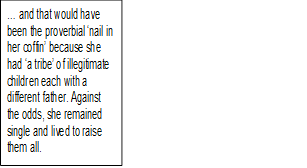

Imagine my angst at endeavouring to put that family tree together. My Eastlight file refused to snap shut in the end!
However, regardless of ambiguities, subterfuge, down-right dishonesty and unsuccessful attempts at obscurity, good old paperspast.natlib.govt.nz delivered 27 accounts of her outrageous behaviours. Not one of the items shed a light on the paternities of her children.
Brick walls do not deter me, they just determine that patience and perseverance prevail. Her background evidenced that she was a Catholic. Time to visit the Catholic Baptismal Archives. I came across one certificate. You might hoodwink a priest on the first occasion but not the same priest, multiple times.
The infant’s baptismal entry revealed the following: Register Number, Year, District, Parish, Church, Priest’s Names , Event Date & Number, Child’s Given & Surname, Residence, Parents’ Given & Surnames, Date of Birth, 2 Sponsors’ Names
Strangely, it was the male sponsor’s name Patrick Starkey (paperspastnz) which elicited information towards the background of the baptised infant’s father, his occupation and time frame for his movements. That time frame coincided with the birth of an earlier child. It appeared highly likely that these two children were full siblings.
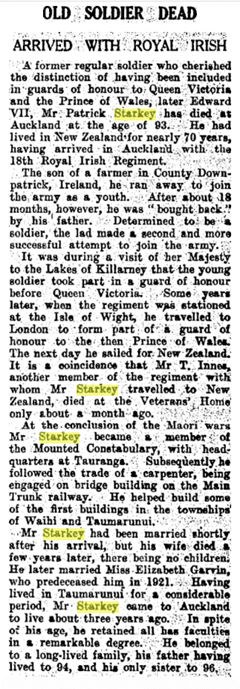
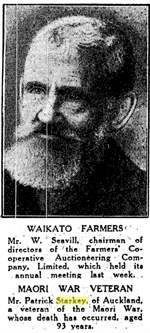
Another breakthrough for paternity confirmation came from NZ BMD which established a birth and death of an infant. In retrieving the certificates I was able to follow through to Archway, Archives N.Z. and find an inquest. I pays me money and duly received the papers. Yes, Sir! The lady stood up and couldn’t wait to name the father of her deceased infant.
A third father’s name appeared as the feminine form of a male name combined with a distinctive middle name which was so obviously a surname that she never ever declared it. It only appeared once when her mother grabbed the father by the scruff of the neck and made an embarrassed seven-year-old child watch the fellow sign a baptismal register before she could receive holy communion. Aren’t family stories wonderful?
Four children down and now I had to graciously give in and admit that I had Buckley’s getting the remaining cohort. I was able to make strong name links for 2 others, to a local farmer who later married a woman and gave his legitimate children the exact same names – ah, but that’s not good enough, is it?
The 16-year-old girl who left her home half a world away, by herself, to come to a strange land over 150 years ago, was a pioneer in her own way. I have watched families visibly shrink from acknowledging this ancestor. But she was prepared to stand up and ‘be counted’ as a person who shaped her community in ways which challenged everything that puritanical settlers believed in. Yes, her way of surviving was different and that difference never harmed anyone. Indeed, there was printed, a lengthy article about how she went out of her way to care for others. She was a staunch suffragette and her name is on the First Women to Vote Register of 1893. No-one puts the names of soiled doves up on a plaque. Odd, because they were the mother’s whose sons went to so many wars. Their daughters were women who made a nation of workers. Without her I would have no tale to tell - she was my great grandmother.
Nancy Vada Gibb
The Silver Spoons
When my Aunt Betty died, carefully packed away among her belongings were 8 silver spoons – 4 with a strange heraldic crest, 3 with an ornate H, and one sugar bowl spoon with an equally ornate W or M.
The H I knew stood for HUNT, my mother and aunt’s maternal family. Grandmother Edith Lilian (Lily) HUNT, then aged three, arrived in Australia in 1879 on the fast steamship Aconcagua with her family – her parents Edwin HUNT 1837-1895 and his Welsh wife Margaret MORGAN 1837-1925, and Lily’s seven older siblings. The M on the sugar spoon most likely stood for MORGAN

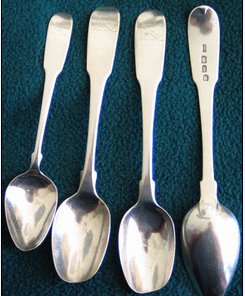

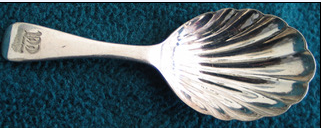
That left the four with the heraldic crest – a fish or eel with a trident. The spoons were obviously very old. Two were very worn on one side indicating constant use by a right-handed person, most likely a child.
Putting aside for the moment the question of age, which could be settled by an examination of the hallmarks, I decided to focus on the heraldic engraving.
In the late 1800s and first half of the 1900s, it was common for many people to believe they had noble antecedents. “They have the same surname, so they must be our ancestors”(!). This was easy to say as it was extremely difficult at that time to check the records, if indeed they existed.
There were several such stories in my mother’s family. One of Edwin and Margaret’s sons, Edwin Herbert HUNT 1866-1921, a bank manager, thought the family were related to the Earl of Somers and Lord and Lady Henry Somerset.
Edwin HUNT’s family were not wealthy. His father was a cordwainer (shoemaker) who was born about 1791 in the little Worcestershire village of Redmarley d’Abitot, son of an agricultural laborer, and Edwin’s mother was almost certainly a maid or governess. At some time about 1823 the family moved to Reading in Berkshire, most likely due to the agrarian closures. Thomas remained a Cordwainer Journeyman according to the 1841 Census.
Edwin started his teaching career early as was the custom of those days. The 1851 Census shows him as a ‘Pupil teacher at Charity school’. He soon became the headmaster of St. John’s Boys’ School in Reading, where he met his future wife Margaret MORGAN 1838-1920, daughter of Cardiff farmer David MORGAN and his wife Margaret LLEWELLYN. By the time they emigrated to Australia, travelling in the saloon of a steamship, they would have been reasonably well off and doubtless took with them all their family silver, household linen and some furniture – some of which remains with the family to this day.
A search of Bernard Burke’s two-volume authoritative work on Crests (“The General Armoury…”) and several similar books was not very helpful. Definitely none of the families whose names (at least) are involved in our family history have a dolphin and/or trident. All sources confirmed that the talbot – a species of hound – was the main item in the family crest of several different Hunt families. The Duke of Somerset’s crest features a phoenix rising from a ducal coronet and another branch of the Somerset in Gloucester has a portcullis. The Somers mostly have a stag, a lion’s head, or a laurel tree, and the Sommers a harvest fly, a lion rampant, a stag or coat of mail. Burke says that a crest is much less individual than a coat of arms, and that up to the 1780s some heraldic authorities opined the crest could be varied at will.
Burke lists at least 60 families whose crest involves a stylistic dolphin or fish, but none include a trident. The trident is strongly significant of a maritime link – but none of the Hunts or associated families had any association with the sea or shipping companies or trade.
Perhaps the hallmarks would yield some information? With the help of several books on hallmarks, widely available in libraries and on-line, I discovered that the 4 spoons with the strange heraldic crest were made by William WARD, a Dublin goldsmith, in 1802. Over 200 years old! The 3 spoons with the initial H were made by the Exeter goldsmiths J. Whipple & Co. in 1879-1880. And the caddy spoon, slightly more recent, was made in Sheffield. Aunt Betty also had a sugar bowl and milk jug with the same ‘bat’s wing flutes’ typical of the 1790’s but since then widely reproduced, and most likely part of the same set.
Edwin Hunt and his family emigrated to Australia in 1879. Maybe they purchased, or were given, the Exeter silver just before they left – a parting gift? But the Dublin spoons are more difficult to explain. Why the nautical theme? Perhaps they were given to the HUNT girls. Of the four spoons, the larger 3 show a graduation in degree of wear, plus the fourth is smaller than the others - corresponding perhaps to the ages of the 4 girls – Fanny b. 1863, Maggie b. 1864, Florence b. 1869 and Lily b. 1876 – aged 16, 15, 10 and 3 at the time the family emigrated. But there had been another sister, a little girl who only lived two years and died three years before the emigration.
The mystery remains.
Chris
Leather
Secrets
and Lies
I grew up with stories told by mother and other relatives, about their ebullient and energetic Irish grandmother, Eliza, and the more reserved grandfather, Philip. The couple had met in Christchurch around 1880, married in January 1882, moved to Blenheim and raised 13 children. Blenheim was a small community; the family was large and my mother spent a lot of time with her much loved grandmother. She only heard stories about her grandfather - he died in 1920, the year my mother was born. However, there were many great-aunts and uncles who knew him. He was reported as quiet, moody, good at making things with his hands and a well thought of member of the community.
I began some research about my great-grandparents, Eliza Doherty and Philip Saul, in the 1990s. Eliza was easy. Other family members had done previous research and met extended family. Several had visited the family home in Ireland where descendants still lived, and contact was maintained over the generations, with Eliza’s Irish family.
Philip was a bit more elusive. A UK birth certificate, NZ marriage certificate and death certificate all confirmed the factual details of who he was. There were also plenty of official records about his father, a well-off London businessman who owned a lot of properties. However, it was hard to pin down when Philip came to New Zealand. Hearsay had him arriving in Auckland on the Hydaspes in 1872 – it seemed to be his story and it was reiterated in his 1920 newspaper obituary. A comprehensive search of shipping records though never showed Philip on that ship or any other in the five years either side of 1872. Nor were there any clues about what Philip did and where he lived between 1872 and when he married Eliza in 1880. According to my mother, he lost contact with his London family, except one sister, when he came to New Zealand. For years I put it all in the “too hard basket”.
Fast forward to 2010. I received an email from someone called Jacqueline, from England, about her great-grandfather, Philip George Saul, who she claimed was the same person as my great-grandfather. She produced copies of census records, a birth certificate and marriage certificate for a Philip Saul, aged 18, who married a Harriet Norris aged 17 in London in 1870. There were also birth certificates of three children born to Harriet and Philip, in 1872, 1874 and November 1880.
This didn’t stack up as being the same person as my great-grandfather, Philip Saul. He was supposed to have arrived in NZ in 1872 on the ship Hydaspes – which means he was unlikely to have been married to Harriet Norris or be the father of her 3 children. However, the doubts started because information about his arrival in NZ was hazy.
Back I went to the National Archives in Wellington and researched all the Hydaspes passenger and crew lists in detail, for 10 years from 1872. The first little ‘crack’ came with the information that the 1872 Hydaspes sailing arrived in Otago, not Auckland as stated in his obituary (and family stories). Philip was not on it – nor any other sailings of that ship until it sank in the English Channel in 1878. I then went through passenger indexes for all arriving ships for the same period, trying to think of other name derivatives. There was no Philip Saul, or any similar name, who arrived in NZ between 1872 and his marriage to my great-grandmother, Eliza, in 1882.
I then found the “Intentions to Marry” (banns) which all intending couples had to register within three months of their wedding. When Philip Saul and Elizabeth Doherty completed their application form in December 1881, Philip said he was a bachelor, aged 27 years and had been in NZ for only 18 months. This put his arrival at maybe May to July 1880, and definitely not 1872. I went back to a more detailed search of all shipping passenger lists for 1880 but there was no Philip Saul who arrived in NZ. I concluded he did not use his real name to travel to New Zealand, whenever he did.
By now we had enough accurate and circumstantial evidence to confirm that my great-grandfather, Philip Saul, was same one as Jacqueline’s and that he had a wife and three children in England, before he came to New Zealand. He had married Harriet Norris in London in December 1870. His first child was born in 1872, his 2nd in 1874 and 3rd child in 1880. He could not have come to NZ in 1872 as per the story he seemed to have fabricated. It is likely that he told the truth for the Intention to Marry of December 1881, about being in NZ for 18 months. However, it was a lie to say he was a bachelor.
Around mid-1880, at the age of 27, he had ‘deserted’ his wife and three children in London and travelled to NZ under an assumed name. The youngest child would have been born after he left London. He ‘married’ again soon after arriving in NZ and had 13 more children. From 1880 to 1920 Philip lived as an upright NZ citizen well involved in the Blenheim community, according to his obituary. We assume he never saw his secret children in London again, or had contact with them, and as far as we know nobody in New Zealand knew his story until more recently.
Over the past decade or so there have been many family discussions about our bigamist great-grandfather and so many questions. How did he maintain his secrets and lies? How much did my great-grandmother know and not share with anyone else?
Why did Philip desert his young family? We don’t know about the relationship with his first wife but he did not divorce her (perhaps not unusual as a divorce was difficult, expensive and possibly ‘sinful’). He had married very young and the couple had three children by the time they were in their mid-20’s – not unusual. The birth date of the first child indicates there was no haste required to get married! Philip was an employed carpenter/joiner, his parents were middle-class London businesspeople and according to Jacqueline his London census addresses did not indicate poverty. He changed his name to travel to New Zealand – standard practice for someone not wanting to be traced but why? He never acknowledged he had another family. How did he manage his secret past so well and not get tripped up until over 100 years later?
There must have been answers, but we will never know them.
An Invitation to Contribute:
I have a number of people that contribute occasional articles. These appear irregularly if and when the authors send them to me. I use them to bulk up each month's newsletter. The more we have the more "rests "I can give my much-appreciated regular columnists.
This is a way that a person can get some of their writing published. Of course, we are all writing up our research results, aren't we? I have always said that every genealogist is an expert in some small piece of history, resources or research methods.
We circulate this newsletter to about 7,000 subscribers worldwide but is read by many more as it is passed on to other readers and LDS research centres. Every month I get feedback on my poor attempts at writing and I have now made many "new friends", albeit digital ones, I have even had some very helpful assistance in my research.
Why don't you contribute an article?
My basic requirements:
1) The column must be in English
2) The column should be no longer than about 1,200 words
3) The article should be emailed to me in a Word document format
4) The subject should be genealogical or historical in nature
Do not be afraid about your "perceived" bad English. The article will be edited, in a friendly manner, by me and then Robert. Then all columnists and a few valuable proof-readers get to read the newsletter before it is emailed out. You’ll be paid $0 for your article, which is on the same scale that Robert and I pay ourselves for editing and publishing the newsletter.
From our Libraries and Museums
We are offering a forum to our libraries and museums to publicise their events, and to contribute articles to this newsletter that may be of interest to our readers. Auckland Libraries makes good use of this free service, let’s see if other libraries and museums take up this offer.
For readers of this newsletter: please bring this to the attention of your local libraries etc, and encourage them to participate.
Auckland Libraries
February — June 2022
Are you interested in family, local and social history, the stories of Aotearoa New Zealand, the Pacific, and beyond?
Then why not come along to one of our fortnightly HeritageTalks | Waha pū-taonga and hear more about both our personal and our shared heritage?
These talks are given by experts in their field and can provide valuable insight into our histories and our cultures.
When: Wednesdays, February to November, 12noon - 1pm
Where: Auckland
Art Gallery Toi o Tāmaki Gallery,
Cnr of Kitchener & Wellesley Streets . Also online via
Zoom
Cost: Free
Bookings: https://www.aucklandlibraries.govt.nz/Pages/family-and-local-history-events.aspx
For queries contact Research Central ph 09 890 2412.
MARCH
Early Chinese restaurants in Auckland with André Taber
Wednesday 2 March 12pm - 1pm
In the 19th century there were several Chinese restaurants in Auckland. They were not decorated with red lanterns and arches, nor did they serve chop suey and chow mein - the world was a very different place back then. André Taber is researching the history of Chinese restaurants in New Zealand and in this talk he will tell you about the establishments of Thomas Quoi, Ah Chee, Samuel Quoi and Thomas Wan Kwai in central Auckland 1879-1922.
Researching Tāmaki Makaurau: Auckland History Initiative Summer Scholars session two
Wednesday 9 March 12pm - 1pm
The Auckland History Initiative (AHI) presents research projects from the 2022 Summer Scholars exploring aspects of Tāmaki Makaurau / Auckland's history. Students spend 12 weeks over summer researching in the varied and rich archives around Auckland under the supervision of Professor Linda Bryder and Dr Jessica Parr. This is the second talk in which the students will present their work. The AHI views Summer Research Scholarships as an integral way to engage students in Auckland history and strengthen relationships with the Auckland GLAMR (galleries, libraries, archives, museums and records) sector.
From Flour to Towers: Josiah Clifton Firth of Auckland and Matamata with Lisa Truttman
Wednesday 16 March 12pm - 1pm
For over 40 years, Josiah Clifton Firth and his businesses were an integral part of Auckland's developing economy in the second half of the 19th century. He was an ultimate capitalist, riding the waves of opportunity to profit by both his businesses and the Waikato War. He was also an obstinate defender of his own self-interests, and a dreamer of dreams that saw the creation of at least two enduring features on the landscape, testaments to his fancies. Join Lisa Truttman as she discusses this life and times of this complex captain of Victorian Auckland industry.
Papers Past with Emerson Vandy
Wednesday 30 March 12pm - 1pm
Papers Past has been around for twenty years now, and over the last year has been making strides in delivering more recent material. This talk will focus on different tools and features the website provides to support different research subjects and approaches; a historian might need to tackle things a bit differently to a genealogist, for example, and a linguist might need to take a different approach to the historian. What’s the best way to find what you need in this collection, and what’s Papers Past got coming up?
APRIL
Connecting to the Pacific through digitalpasifik.org with Taputukura Raea
Wednesday 13 April 12pm - 1pm
digitalpasifik.org is a website to explore, discover and view the diverse cultural heritage of the Pacific. Pacific collections are found in repositories around the world that are often inaccessible for many Pacific people. digitalpasifik.org is a website that allows Pacific people to access their digitised cultural heritage. Find out how the team is making these records visible, and how you can contribute!
Online Cenotaph celebrating 25 years with Victoria Passau, Auckland Museum
Wednesday 20 April 12pm - 1pm
Online Cenotaph is a military database of Aotearoa New Zealand service personnel. Managed by Tāmaki Paenga Hira Auckland War Memorial Museum, the database includes more than 255,000 individual records spanning the South African Wars to today. It is utilised and enriched by veterans, whānau, genealogists and researchers alike. December 2021 marked 25 years of telling the stories of military veterans and their comrades. Join Victoria Passau Collection Manager, Online Cenotaph, in an exploration of the history and impact of this resource over the past quarter century.
A history of the Anglican Trust for Women and Children with Ruth Greenaway and Megan Hutching
Wednesday 27 April 12pm - 1pm
Oral historians Ruth and Megan will talk about the history of this Auckland organisation which began with an orphan home in the central city in 1858 and now works with its community in South Auckland. While society has undeniably changed since the middle of the 19th century, the problems of today’s clients bear a marked resemblance to the issues confronting those who came for help in the early days – lack of housing, an inability to keep a family together, the experience – by women in particular – of abuse or neglect as children or adults.
Nga mihi | Kind regards
SEONAID
Seonaid (Shona) Lewis RLIANZA | Family History Librarian
Central Auckland Research Centre, Central City Library
Heritage and Research
Auckland Libraries - Nga Whare Matauranga o Tamaki Makarau
Ph 09 890 2411| Extn (46) 2411 | Fax 09 307 7741
Auckland Libraries, Level 2, Central City Library, 44 - 46 Lorne Street, Auckland
Visit our website: www.aucklandlibraries.govt.nz
@Kintalk on Twitter / Auckland Research Centre on Facebook
Group News
Whangarei Family History Computer Group
Contacts:
 Wayne: (09)
437 2881 wayne@bydand.co.nz
Wayne: (09)
437 2881 wayne@bydand.co.nz
Pat: (09) 437 0692 whangareifamilyhistorygroup@gmail.com
Venues
Thursday evening venue is 6 Augusta Place, Whau Valley. Call Wayne or Pat or;
email Whangareifamilyhistorygroup@gmail.com, if you need directions.
Saturday meetings are held in the SeniorNet rooms in James Street.
The rooms are upstairs in the Arcade leading to Orr’s Pharmacy and Tiffany’s Café, Start time 9.30 till finished before 1.30pm.
Waikanae Family History Group
 Contacts: Email: wfhg2012@gmail.com
Contacts: Email: wfhg2012@gmail.com
Venue: Meets every 4th Thursday morning at the Waikanae Chartered Club, 8 Elizabeth Street Waikanae, just over the Railway Crossing from 9.30am to 12 -12.30pm, every month from January to November.
Research days: at the Waikanae Public Library, 10am to 12 noon on second Wednesday of each month.
Waitara Districts History &
Families Research Group
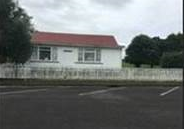 The contact details of this group
are:
The contact details of this group
are:
Waitara Districts History & Families Research Group
Rose Cottage 33 Memorial Place
WAITARA 4320
Tel: 06 – 754 – 3212
waitarahistory.genealogy@xtra.co.nz
President:- Rona Hooson
Vice President:- Doree Smith
Secretary:- Trish Smart
Treasurer:- Marilyn O’Lander
office:-067543212
News
and Views
|
|
|
ious Articles Worth
Reading
From the Editor: Because of space restrictions and copyright issues I cannot put the complete articles in this newsletter so here are some URLs that are worth looking at:
The women of the New Zealand
goldfields
Find your 19th- and 20th-century New
Zealand ancestors in a huge new electoral roll records release at FamilySearch
The newly available collection contains electoral rolls from New Zealand for the years 1865 to 1957 and is taken from microfilm of original records at the Wellington General Assembly Library, Wellington.
It consists of registers of persons qualified to vote for members of the House of Representatives. The records are grouped by electoral district, then by surname.
Information that you can find in the records includes:
the person’s name
residence
electoral district
qualifying residence type
location of property.
Search the collection at FamilySearch.
Australian Shipping and Passenger Records
Explore this website and go into the individual state sections and get lost in all the options!!!
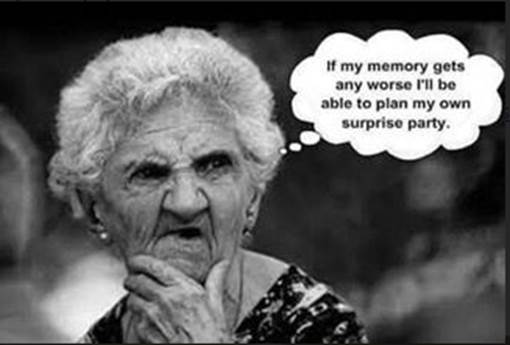
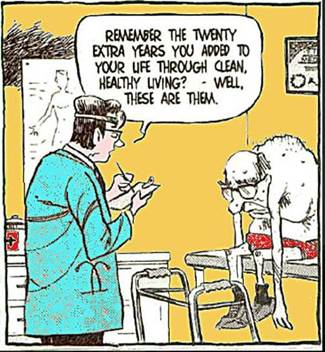
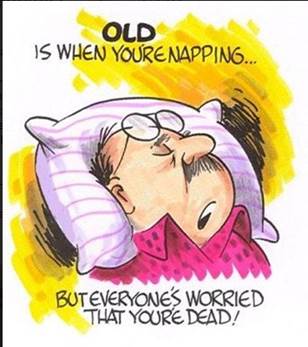
When is a Father
a Father?
Now here is an article that I wish I had written.
https://chiddicksfamilytree.com/2017/11/26/when-is-a-father-a-father/
How to Research a WW1 Soldier
https://chiddicksfamilytree.com/2021/03/28/how-to-research-a-ww1-soldier/
How to find divorce records in
England and Wales
https://www.whodoyouthinkyouaremagazine.com/tutorials/divorce-records/
How to find name change records in
the UK
https://www.whodoyouthinkyouaremagazine.com/tutorials/name-change-records-uk/
Here’s to the
Non-Genealogists
https://news.legacyfamilytree.com/legacy_news/2022/02/heres-to-the-non-genealogists.html
In conclusion
Book Reviews
Help
wanted
Letters to the Editor
Advertising with FamNet
Every now and then we get requests to put an advertisement in the newsletter. I have therefore created a new section which will appear from time to time. Advertisements will be included only at the Editor's discretion and will be of a genealogical nature.
If your organisation is not a group subscriber then there will be a charge for advertising events and services, which must be paid for before publication. Charges start at $NZ25 for a basic flier, and increase for more elaborate presentations. Like everyone else we need funds to help keep FamNet going. Fees are very minimal. If your organisation paid a yearly subscription you can have all the advertising you want all year round in the Group News section. Your group could be anywhere in the world, not just in New Zealand. The editor will continue to exercise discretion for free events.
A Bit
of Light Relief
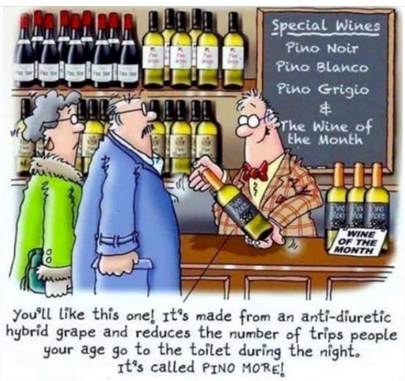
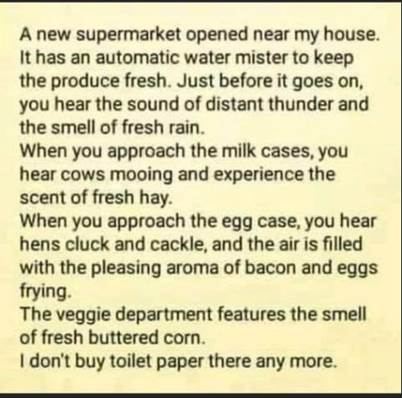
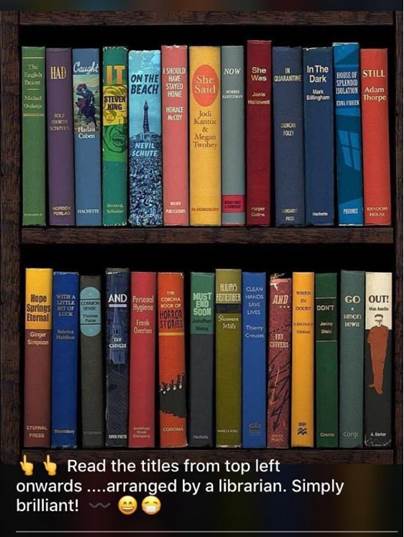


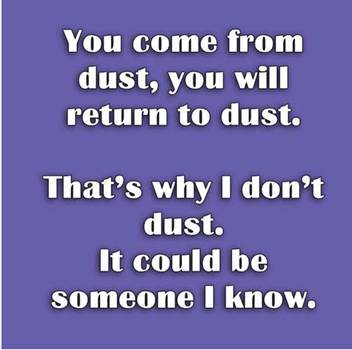
To Unsubscribe, Change your Email Address, or Manage your Personal Information
If you have problems with this page you can email us directly, but the page should be self-explanatory.
Copyright
(Waiver)
Feel free to redistribute this newsletter. If you publish a newsletter yourself you may include material from this newsletter in yours provided that you acknowledge its source and include the FamNet URL. https://www.famnet.org.nz/
 From
the editor: Helen is taking a break this month. It is a pity because I
enjoy reading her column because I learn more about a bit of NZ history that
I was unaware of.
From
the editor: Helen is taking a break this month. It is a pity because I
enjoy reading her column because I learn more about a bit of NZ history that
I was unaware of.
